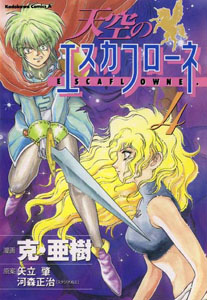It is not unusual that the story of Escaflowne has been told in a manga series as well as an anime series. It is, however, a bit unusual for the character designs and storyline to diverge so dramatically. Though all the versions of Escaflowne credit the original concept to Hajime Yadate and Souji Kawamori, the perspective of the actual writers greatly influences the way the story develops. For instance, the world of Gaea, the characters of Van, Hitomi, Allen, even Millerna, and the Guymelf Escaflowne can all be found in theTenkuu no Escaflowne manga series by Aki Katsu, a series which started a few years before the anime aired. But the characters are virtually unrecognizable when compared to their anime counter parts. For example, Hitomi, looks and acts completely different. Her hair is long and she wears glasses.This Hitomi is far more timid, but at the same time, for some reason, tends to have a lot less clothes on. ^_^;; Needless to say, this series runs in a shonen (boy's) manga.
All the characters are different to some degree. Van has a much rougher, wilder appearance. He is much more tempermental and volatile. So far, Allen has not played as big a role in this manga series. He is their steadfast ally, who aids them when they are in a pinch. Allen is also not really much Van's rival for Hitomi's affections. Millerna does not play much of a role at all. With shoulder length brown hair, she is the meek but possesive princess to whom Allen is, seemingly rather unenthusiastically, engaged. In the first manga series, Dilandau is also quite different. He is older, he seems to be about Allen's age rather than Van's. Dilandau seems to be much more of a effeminate man than a pretty, young boy. Escaflowne also looks different, with the bust of a unicorn projecting from it's chest. Also, there is much more room inside Escaflowne, as three people are regularly inside of it in the manga.

There are also charaters in the manga that are not in the anime at all. Shan, the warrior maiden for example. Also, Van's mother plays a larger role in the manga, but she seems to be a completely different character. Her named is not the same and she looks nothing like Varie in the anime. And, of course, there are characters in the anime you will not find in the manga. The most significant of these omissions are, in my opinion, Merle and Folken. Without these characters, I feel the story loses a lot in terms of depth. At any rate, I far prefer the anime story to the story in this manga series.
In addition to the characters, the story is also quite different. The basic plot is similar enough, a girl named Hitomi is transported to the world of Gaea where she meets the prince of the kingdom of Fanelia and a knight of the kingdom of Astoria, who reminds her of the upper classmen she has a crush on. She becomes involved in their battle against the Zaibach empire. From there, just about anything goes. For instance, as in the anime, there is a stone called energist, and it still powers Escaflowne. However, in the manga, Hitomi's body is made from energist while she is on Gaea (her real body is still on earth). So she powers Escaflowne by placing her hands on a control panel within Escaflowne's cockpit. Hitomi also undergoes a physical transformation when she does this. She becomes a, rather busty, blond. To the left, you can see a post-trasformation Hitomi, along with Van, on this cover to the volume 4 tankoubon of the first Tenkuu no Escaflowne manga series released by Kadokawa Comics.
Another of Escaflowne's interesting manga connections is the manga series by Yuzuru Yashiro, which began around the same time the television series started. This one is a shoujo (girl's) manga series. Still, it is also a bit different from the anime. Hitomi, again, has long hair. Though she sometimes wears it in a ponytail, so that from the front it almost looks like she has short hair. Hitomi also seems to have a bit more serious personality, more befitting the traditional shoujo heroine. Van looks pretty much the same, with the exception of an unusual mark on the back of his hand. This symbol just happens to be the same as those on the back of Hitomi's tarot card set. A Tarot card set which, in this version of the story, Hitomi received from her grandmother along with the pendant. Also present are Folken and Allen's sister, Serena(!). Noticably absent, once again, is Merle.
As for the story itself, though the battle with the Zaibach Empire is still the same, there is definitely a bigger focus on character relationships and intrigue. For example, there appears to be more to Hitomi's grandmother's connection to Gaea in the manga than there was in the anime. The triangle of Van, Hitomi and Allen seems to be alive and well. Folken is, once again, a member of the Zaibach forces, but he seems more malicious in this story. I have only read the first tankoubon of this series, but the Guymelf Escaflowne has yet to make an appearance. The cover of the first tankoubon of the new Asuka Comics version of Tenkuu no Escaflowne is shown at the right.
Neither of these series has ended yet. The Kadokawa series is currently running in the monthly manga, Shonen Ace and the Asuka series is featured every month in Fantasy DX.
Just for the sake of comparison, here we have the three different versions of Hitomi. Very interesting contrast, to say the least. ^_^

Last Update: 11/20/96